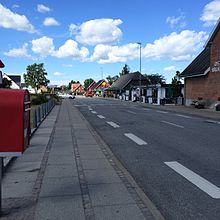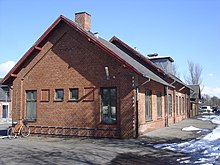Planned railway lines on Himmerland
The planned railway lines on Himmerland were three branch lines in the historical landscape of Himmerland , the north-eastern part of the Danish Jutland peninsula , which were passed with various railway laws, but never came to fruition. All projects were planned as private railways , where the Danish state would have assumed half of the construction costs.
Aars – Arden – Øster Hurup railway line
The railway line Aars – Arden – Øster Hurup ( Danish Aars – Arden – Øster Hurup Jernbane ) was a railway line that was decided by the great railway law of March 20, 1918 , but was not built.
In Østhimmerland there were big plans to build a port in Øster Hurup . From there a steamboat connection to Hundested was to be built and connected to most of the railway lines built in Himmerland.
The line should consist of two parts and be operated by Sydhimmerlands Jernbaneselskab (SHJS) :
- Aars-Arden
- from Arden to a point on the Aalborg – Hadsund railway line, which was later specified with Bælum , possibly with continuation to Øster Hurup.
The routes should have a length of 64.6 kilometers. Eleven train stations were to be built at it:
- Aars - with a connection to the Himmerlandsbanerne and the Aalborg – Hvalpsund railway line
- Giver
- Sønderup
- Haverslev - junction with the undeveloped Aalborg – Nørager railway line
- Mejlby
- Ravnkilde
- Arden - connection to the Randers – Aalborg railway line
- Rostrup
- Astrup
- Tisted
- Terndrup
- Bælum - connection to the Aalborg – Hadsund railway line
- Øster Hurup - connection to the undeveloped Skelund – Als – Øster Hurup railway line
To this end, the seven stops at Bistedbro, Nysum, Gandrup, Lundgård, Vrå, Solbjerg Enge and Haslevgård were to be built. In Arden, the Danske Statsbaner did not want to accept a level introduction to their route. The proposal is to run the line with a viaduct under the state railway line and to build its own station as a terminus . The same level threading was accepted for Haverslev and Bælum.
The concession for the construction was granted on May 28, 1919, after which the route was mapped out. In 1920, local needs were recorded in a survey and discussed with the local authorities.
Although the plans were very advanced, it was decided to suspend the plans in view of the difficult economic environment and the rise of the automobile and freight routes. The 1923 Railway Commission, which was supposed to evaluate the projects contained in the law, recommended that the construction of the line be abandoned.
Aalborg – Nørager railway line
The railway line Aalborg – Nørager ( Danish Nøragerbanen ) was a railway line which, like the lines Aars – Arden – Øster Hurup, Skelund – Als – Øster Hurup and Sebbersund – Løgstør – Overlade , was decided with the great railway law of March 20, 1918 , but not built has been.
The route should have a length of 63.3 kilometers. 15 stations were to be built at it:
- Aalborg - with connection to the railway Randers-Aalborg , Aalborg-Frederikshavn Line , railway Aalborg-Hadsund and railway Fjerritslev-Frederikshavn
- Restrup
- Nørholm
- Sønderholm - junction with the Aalborg – Hvalpsund railway line
- Moldbjerg
- Øster Hornum
- Byrsted
- Hjeds
- Hyllested
- Suldrup
- Aarestrup
- Haverslev - junction with the undeveloped Aars – Arden – Øster Hurup railway line
- Mejlby
- Kongens Tisted
- Nørager - connection to Himmerlandsbanerne
The route between Aalborg and Sønderholm should be more direct than the Hvalpsundbane and without the steep gradients there. There were even plans to close the mountain railway between Svenstrup and Sønderholm and to run the Aalborg – Hvalpsund line over the new line between Aalborg and Sønderholm. The Nøragerbane would have been a strong competitor to the Hvalpsundbane , which wanted to pay very well for the necessary expansion of the station in Sønderholm and the increase in staff necessary for the operation of the station.
The 1923 Railway Commission, which was supposed to evaluate the projects contained in the law, was of the opinion that the Nøragerbane could carry out the operation, but a return on the capital invested was not to be expected. Because of the competition with the Hvalpsundbane and the Hobro – Aalborg railway line of the state railway, construction was discouraged.
Sebbersund – Løgstør – Overlade railway line
The Sebbersund – Løgstør – Overlade railway line was a railway line that, like the Aars – Arden – Øster Hurup, Skelund – Als – Øster Hurup and Aalborg – Nørager railway lines, was decided by the Great Railway Act of March 20, 1918 , but was not built.
The route should have a length of 42.6 kilometers, the Sebbersund – Løgstør section 26.6 kilometers. The following train stations and stops were to be built at it:
- Sebbersund - with a connection to the Aalborg – Hvalpsund railway line
- Sebbersund by
- Farstrup
- Lundby
- Brøndum
- Kornum
- Løgstør - with a connection to the Himmerlandsbanerne
- Vilsted
- Ranum
- Overload
The Sebbersund station on the Aalborg – Hvalpsund line on the east side of the Sebber Sund should be expanded. From here the route should lead over the Sebber Sund on a dam next to the road to the town of Sebbersund.
The line would have made a shorter connection between Aalborg and Løgstør than via Aars, so that the railroad could have rivaled coastal shipping. Hvalpsundbanen commented positively on the project, although the tariff route would have been reduced from 50 km via Aars to 29 km via Sebbersund.
The 1923 Railway Commission, which was to evaluate the projects included in the 1918 Act, felt that the line would have significant freight traffic between Aalborg and Løgstør and suggested that some of the passenger trains to and from Aalborg should be operated. However, the Commission advised that the line should be built at a time when construction costs were lower and transport needs were greater.
Railway Skelund – Als – Øster Hurup
The railway line Skelund – Als – Øster Hurup was a railway line that, like the lines Aars – Arden – Øster Hurup, Sebbersund – Løgstør – Overlade and Aalborg – Nørager , was decided by the Great Railway Act of March 20, 1918 , but was not built.
The law contained a branch line from Skelund to Als with a possible extension to Øster Hurup . This project came about in connection with the great plans to build a port in Øster Hurup. From there, steamships should run to Hundested and connect most of the railway lines that run on Himmerland. The Sydhimmerlands Jernbaneselskab (SHJS) applied for the concession, which was granted on May 28, 1919. In addition, the route was checked and marked out.
The lines should be nine kilometers long and constructed as follows:
- Skelund - connection to the Aalborg – Hadsund railway line
- Buddum
- As
- Helberskov
- Øster Hurup - connection to the undeveloped Aars – Arden – Øster Hurup railway line
Web links
- Nordjyllands Jernbaner: Aldrig byggede baner. In: Nordjyllands jernbaner. Retrieved September 9, 2015 (Danish).
Individual evidence
- ↑ Hans Jørn Fred Berg and Poul Thor Hansen: Aalborg Hvalpsund Jernbane . Ed .: Dansk Jernbane-Klub. No. 58 , 2009, p. 227-229 .
- ↑ Hans Jørn Fred Berg and Poul Thor Hansen: Aalborg Hvalpsund Jernbane . Ed .: Dansk Jernbane-Klub. No. 58 , 2009, p. 229 and 232 .
- ↑ Hans Jørn Fred Berg and Poul Thor Hansen: Aalborg Hvalpsund Jernbane . Ed .: Dansk Jernbane-Klub. No. 58 , 2009, p. 227 .



